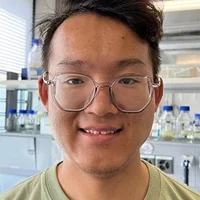Research interests
Our research aims at understanding the structure and function of amyloid aggregates in neurodegeneration with two objectives:
(1) Single-molecule nanopore engineering and trapping for studying amyloid proteins
In Alzheimer’s Disease (AD) and Parkinson’s Disease (PD), Aβ and α-synuclein can aggregate into transient oligomers, and eventually deposit as insoluble fibrils. Amyloid oligomers are responsible for neuronal dysfunction through various toxic pathways, which include permeabilizing cellular membranes. These transient oligomers are heterogeneous, which greatly hinders research into their mechanisms and adds serious problems to the development of antibody-based therapies. Recently we showed that uniform, homogeneous, stable oligomers can be engineered by displaying Alzheimer’s Aβ peptides on α-hemolysin (αHL). These complexes have biochemical characteristics that are very similar to disease-related wild-type oligomers. Cryo-EM studies confirmed that the αHL-displayed oligomers have a well-defined stoichiometry, thus providing a stable mimetic antigen for the structure determination and the development of conformation-specific antibodies. The same αHL-fusion approach can also allow engineering antimicrobial peptides and developing a novel biological nanopore. We will further optimize stoichiometry-defined and functionally relevant amyloid oligomers for structural and functional characterization. We will study these artificial amyloid (Alzheimer’s Aβ and Parkinson’s α-syn) oligomers in vitro using structure determination as well as biophysical technologies. In a C. elegans model, we aim at investigating their functional equivalence to the wild type oligomers.
To further confirm the equivalent function, we will raise the conformation-specific antibodies against these optimized Aβ oligomers, and test whether the antibodies can interfere with the membrane permeabilization in vitro and check to what extent the antibodies against αHL-fused oligomers can impact AD in a mouse model. We propose using recent advances achieved at the TOMCAT beamline (Swiss Light Source) in X-ray phase-contrast imaging (X-PCI) to study the impact of the antibodies on the brain’s spatial microstructures. Collaboration with University Hospital Zurich (UHZ) opens the path towards animal and clinically relevant experiments. This highly interdisciplinary project not only allows us to move forward the high-resolution X-ray bio-imaging applications at PSI, but also contributes to the nanoscopic spatial understanding of oligomeric toxicity, and changes in the microstructure and cellular structure associated with neurodegeneration in vivo. Through this project, we hope to contribute molecular mechanisms and novel approaches in developing diagnostics and therapeutics for neurodegenerative diseases like AD.
(2) Characterizing the structure and function of amyloid condensates with the disease-related molecules in neurodegeneration by using X-ray spectroscopy, scattering and imaging techniques
A growing body of work is revealing the important role of initial amyloid protein condensation in the formation of amyloid fibrils in vitro. It is still unclear how the disease-related molecules initiate or prevent the conversion towards condensation in vivo. The important interacting molecules that we have already studied for Alzheimer’s Aβ fibrillation at PSI are heat shock protein 90 (Hsp90), Alzheimer’s tau protein as well as the metal ions. We characterised the molecular effects of these interacting partners on amyloid formation, including the kinetics of structural conversions from unstructured peptide monomers to aggregates with variable degrees of β-sheet structures, and the toxicity of a variety of intermediate oligomers. We observed that ATP modulates Hsp90's conformational dynamics and reduces its hydrophobic surface to down-regulate its inhibition against Aβ fibrillation. We found that the full-length tau protein solubilizes Aβ40 and prevents its fibrillation. The tau protein delays the Aβ40 fibrillation at sub-stoichiometric ratios, showing different binding affinities toward the different stages of the aggregated Aβ40. This helps to understand the interplay of tau and Aβ in AD. In collaboration with Dr. Dreiser at SLS (the Xtreme beamline), the spectral features of the peptides and AD-related Cu were simultaneously characterized by recording spectra at the N K edge and at the Cu L2,3 edges. The Cu L2,3 edge shows a fingerprint of monovalent Cu(I), coordinated with the peptides. Furthermore, aggregation leads to a smaller signature of Cu(I). This fingerprint of Cu(I) from Copper L2,3 edge spectroscopy can be further explored as a biomarker of cerebrospinal fluid (CSF) for the diagnosis of Alzheimer’s disease.
Our previous achievements over the past 4 years provide the physical and chemical insights into the participation of the disease-related molecules in Aβ fibrillation and toxicity in vitro5. We further plan to investigate this molecular interplay, using X-ray tomographic reconstruction of amyloid condensates and cellular organelles relevant to neurodegeneration in a mouse brain and a living C.elegans. In close collaboration with Prof. Aguzzi at UHZ and Dr. Bonnin at PSI, we aim at expanding this study to also include using light-sheet fluorescence microscopy. We will further characterize the function of amyloid condensates and test whether amyloid condensation can drive the formation of toxic metallic nanoparticles, which we propose contribute to cellular toxicity both in vitro and in C.elegans. The disease-related metal state and local amyloid condensates or amyloid deposits will be characterized by soft X-ray spectroscopy and ptychography of the SIM and Xtreme beamlines in collaboration with Dr. Dreiser and Dr. Kleibert at SLS. The new aspects will shed light on pathological mechanism of neurodegeneration at mesoscales and provide a fundamental basis for targeted intervention of neurodegeneration. These may revolutionize understanding of the root cause of AD and PD.
References
(1) Wu, J., Blum, T. B., Farrell, D. P., DiMaio, F., Abrahams, J. P., and Luo, J*. (2021) Angew. Chemie - Int. Ed. 60, 18680–18687.
(2) Wu, J., Cao, C., Loch, R. A., Tiiman, A., and Luo, J*. (2020) Q. Rev. Biophys. 53, e12.
(3) Wang, H., Lallemang, M., Hermann, B., Wallin, C., Loch, R., Blanc, A., Balzer, B. N., Hugel, T., and Luo, J*. (2021) J. Mol. Biol. 433, 166717.
(4) Wallin, C., Hiruma, Y., Wärmländer, S. K. T. S., Huvent, I., Jarvet, J., Abrahams, J. P., Gräslund, A., Lippens, G., and Luo, J*. (2018) J. Am. Chem. Soc. 140, 8138–8146.
(5) Luo, J.*, Wang, H., Wu, J., Romankov, V., Daffé, N., and Dreiser, J*. (2021) iScience 24, 103465.
Short CV
2017.07-now: Principal Investigator, Paul Scherrer Institute, Switzerland
2014.12-2017.06: Research Fellow, Oxford University, UK (with Hagan Bayley)
2014.06: PhD, Leiden University, the Netherlands (with Jan Pieter Abrahams)
2009.06-2009.12: Traineeship, EMBL, Germany (with Paul Tucker)
2009.06: MSc, Uppsala University, Sweden
Group Members
Postdoc researcher (joint with Axel Abelein's group, Karolinska Institute)
Guest Ph.D student from the University of Tokyo
Former Group Members
Fangyuan Duan (2022, Exchange Ph.D student, Harbin Institute of Technology)
Jinming Wu (Ph.D student 2018-2022. next destination: Lund University)
Hongzhi Wang (2018-2021 Ph.D student, next destination: Chinese Academy of Sciences)
Hegne Pupart (Summer intern 2018; next destination: Ph.D student at Tallinn University of Technology)
Publications
2024
Phase Separation and Aggregation of α-Synuclein diverge at different salt conditions.
Rebecca Sternke-Hoffmann, Xun Sun, Andreas Menzel, Miriam Dos Santos Pinto, Urte Venclovaite, Michael Wördehoff, Wolfgang Hoyer, Wenwei Zheng*, Jinghui Luo*.
Advanced Science. 2024 Jul 7:e2308279.
DOI:10.1002/advs.202308279
Self-Adaptive Synthesis of Non-Covalent Crosslinkers while Folding Single-Chain Polymers.
Dawei Qi, Xuncheng Shi, Caihong Lin, Ferdinand Holzhausen, Liljeström Ville, Xun Su, Jinghui Luo, Leena Pitkänen , Ya Zhu, Jessica Rosenholm, Sirpa Jalkanen, Jianwei Li.
Angew Chem Int Ed Engl. 2024. 29:e202408670.
DOI:10.1002/anie.202408670
Channel Activities of the Full-Length Prion and Truncated Proteins.
Jinming Wu, Xue Wang, Asvin Lakkaraju, Rebecca Sternke-Hoffmann, Bilal M Qureshi, Adriano Aguzzi, Jinghui Luo*.
ACS Chem Neurosci . 2024;15(1):98-107. doi: 10.1021/acschemneuro.3c00412.
DOI:10.1021/acschemneuro.3c00412
Visualizing alpha-synuclein and iron deposition in M83 mouse model of Parkinson's disease in vivo.
Nadja Straumann, Benjamin F Combes, Xose Luis Dean Ben, Rebecca Sternke-Hoffmann, Juan A Gerez, Ines Dias, Zhenyue Chen, Benjamin Watts, Iman Rostami, Kuangyu Shi, Axel Rominger, Christian R Baumann, Jinghui Luo, Daniela Noain, Roger M Nitsch, Nobuyuki Okamura, Daniel Razansky, Ruiqing Ni.
Brain Pathol. 2024 9:e13288.
DOI:10.1111/bpa.13288
2023
Oligomer Dynamics of LL-37 Truncated Fragments Probed by α-Hemolysin Pore and Molecular Simulations.
Chang Liu#, Anja Henning-Knechtel#, Nicklas Österlund, Jinming Wu, Guangshun Wang, Ruth Astrid Olivia Gräslund, Serdal Kirmizialtin, Jinghui Luo*
Small, e2206232
DOI:/10.1002/smll.202206232
Protein Oligomer Engineering: A New Frontier for Studying Protein Structure, Function, and Toxicity.
Chang Liu, Jinghui Luo*
Angewandte Chemie, e202216480
DOI:/10.1002/ange.202216480
Cross interactions between Apolipoprotein E and amyloid proteins in neurodegenerative diseases
Rolf Antonie Loch#, Hongzhi Wang#, Alex Perálvarez Marín, Philipp Berger, Henrietta Nielsen, Angeliki Chroni, Jinghui Luo*
Computational and Structural Biotechnology Journal (in press)
DOI:10.1016/j.csbj.2023.01.022
Single-molecule nanopore dielectrophoretic trapping of a-synuclein with lipid membranes
Jinming Wu, Tohru Yamashita, Andrew D. Hamilton, Sam Thompson, Jinghui Luo*
Cell reports physical science, 4, 2023: 101243
DOI:10.1016/j.xcrp.2022.101243
2022
Multivariate effects of pH, salt, and Zn2+ ions on Aβ40 fibrillation
Hongzhi Wang, Jinming Wu, Rebecca Sternke-Hoffmann, Wenwei Zheng, Cecilia Mörman, Jinghui Luo*
Communications Chemistry 5, 2022: 171
DOI:10.1038/s42004-022-00786-1
Identifying the role of co-aggregation of Alzheimer’s Amyloid-beta with amorphous protein aggregates of non-amyloid proteins
Jinming Wu, Nicklas Österlund, Hongzhi Wang, Rebecca Sternke-Hoffmann, Hegne Pupart, Leopold L. Ilag, Astrid Gräslund, Jinghui Luo*
Cell reports physical science, 3, 2022: 101028
DOI:110.1016/j.xcrp.2022.101028
Evaluation of Zn2+- and Cu2+-Binding Affinities of Native Cu,Zn-SOD1 and Its G93A Mutant by LC-ICP MS
Julia Smirnova, Julia Gavrilova, Andra Noormägi, Karin Valmsen, Hegne Pupart, Jinghui Luo, Vello Tõugu, Peep Palumaa
Molecules, 27, 2022: 3160
DOI:10.3390/molecules27103160
Cu2+ ions modulate the interaction between α-synuclein and lipid membranes
Hongzhi Wang, Cecilia Mörman, Rebecca Sternke-Hoffmann, Chia-Ying Huang, Andrea Prota, Pikyee Ma, Jinghui Luo*
Journal of Inorganic Biochemistry, 236, 2022: 111945
DOI:10.1016/j.jinorgbio.2022.111945
Rationally designed helical peptidomimetics disrupt α-synuclein fibrillation
Clementine E Bavinton, Rebecca Sternke-Hoffmann, Tohru Yamashita, Peter C Knipe, Andrew D Hamilton, Jinghui Luo*, Sam Thompson*
Chemical Communications, 58, 2022: 5132-5135
DOI:10.1039/D2CC00212D
2021
Editorial: The Biochemistry of Amyloids in Neurodegenerative Diseases, Volume I
Gomes C, Hoyer W, Luo J.
Frontiers in Neuroscience, 819481, 2021
DOI:10.3389/fnins.2021.819481
Amyloid-beta–copper interaction studied by simultaneous nitrogen K and copper L2,3- edge soft X-ray absorption spectroscopy
Luo J, Wang H, Wu J, Romankov V, Daffe N, Dreiser J
iScience 24, 103465, 2021
DOI:10.1016/j.isci. 2021.103465
Cryo-electron microscopy imaging of Alzheimer's amyloid-beta 42 oligomer displayed on a functionally and structurally relevant scaffold
Wu J, Blum TB, Farrell DP, DiMaio F, Abrahams JP, Luo J.
Angew Chem Int Ed Engl . 2021 May 27.
DOI:10.1002/anie.202104497.
ATP Impedes the Inhibitory Effect of Hsp90 on Aβ40 Fibrillation
Wang H , Lallemang M , Hermann B , Wallin C , Loch R, Blanc A, Balzer BN, Hugel T, Luo J
Journal of Molecular Biology 433 (2), 166717 (2021).
2020
Antimicrobial Peptide Mimetics Based on a Diphenylacetylene Scaffold: Synthesis, Conformational Analysis, and Activity
Peacock H, Henriques ST, Benfield AH, Elliott AG, Luo J, J Luccarelli, Nagano M, Craik D, Hamilton A
ChemMedChem. 15 (20), 1932-1939 (2020).
Single-molecule studies of amyloid proteins: from biophysical properties to diagnostic perspectives
Wu J, Cao C, Loch RA, Tiiman A, Luo J
Quarterly Reviews of Biophysics. 53:e12 (2020).
2019
- Nuclear Pore Membrane Proteins Self-Assemble into Nanopores
BIOCHEMISTRY 58, 484 (2019).DOI: 10.1021/acs.biochem.8b01179
2018
-
Membrane-mimetic systems for biophysical studies of the amyloid-? peptide
BIOCHIMICA ET BIOPHYSICA ACTA (BBA) - PROTEINS AND PROTEOMICS , S1570963918302036 (2018).DOI: 10.1016/j.bbapap.2018.11.005
-
The Neuronal Tau Protein Blocks in Vitro Fibrillation of the Amyloid-? (A?) Peptide at the Oligomeric Stage
JOURNAL OF THE AMERICAN CHEMICAL SOCIETY 140, 8138 (2018).DOI: 10.1021/jacs.7b13623
2017
-
Alzheimer?s disease and cigarette smoke components: effects of nicotine, PAHs, and Cd(II), Cr(III), Pb(II), Pb(IV) ions on amyloid-? peptide aggregation
Scientific Reports 7, 14423 (2017).DOI: 10.1038/s41598-017-13759-5
-
Maleimido-proxyl as an EPR spin label for the evaluation of conformational changes of albumin
European Biophysics Journal 46, 773 (2017).DOI: 10.1007/s00249-017-1257-z
2016
-
Characterization of Mn(II) ion binding to the amyloid-? peptide in Alzheimer?s disease
JOURNAL OF TRACE ELEMENTS IN MEDICINE AND BIOLOGY , (2016).DOI: 10.1016/j.jtemb.2016.03.009
-
Coupled commensurate charge density wave and lattice distortion in Na2Ti2Pn2O(Pn=As,Sb) determined by x-ray diffraction and angle-resolved photoemission spectroscopy
PHYSICAL REVIEW B 94, 104515 (2016).DOI: 10.1103/PhysRevB.94.104515
-
Cross-interactions between the Alzheimer Disease Amyloid-? Peptide and Other Amyloid Proteins: A Further Aspect of the Amyloid Cascade Hypothesis
JOURNAL OF BIOLOGICAL CHEMISTRY 291, 16485 (2016).DOI: 10.1074/jbc.R116.714576
-
Non-covalent S?O interactions control conformation in a scaffold that disrupts islet amyloid polypeptide fibrillation
CHEMICAL SCIENCE 7, 6435 (2016).DOI: 10.1039/C6SC00756B
-
Reciprocal Molecular Interactions between the A? Peptide Linked to Alzheimer?s Disease and Insulin Linked to Diabetes Mellitus Type II
ACS Chemical Neuroscience 7, 269 (2016).DOI: 10.1021/acschemneuro.5b00325
-
Specific Binding of Cu(II) Ions to Amyloid-Beta Peptides Bound to Aggregation-Inhibiting Molecules or SDS Micelles Creates Complexes that Generate Radical Oxygen Species
Journal of Alzheimer's Disease 54, 971 (2016).DOI: 10.3233/JAD-160427
-
The Amyloid-? Peptide in Amyloid Formation Processes: Interactions with Blood Proteins and Naturally Occurring Metal Ions
ISRAEL JOURNAL OF CHEMISTRY 57, 674 (2016).DOI: 10.1002/ijch.201600105
2014
-
Alzheimer Peptides Aggregate into Transient Nanoglobules That Nucleate Fibrils
BIOCHEMISTRY 53, 6302 (2014).DOI: 10.1021/bi5003579
-
ChemInform Abstract: Cyclic Peptides as Inhibitors of Amyloid Fibrillation
ChemInform 45, no (2014).DOI: 10.1002/chin.201422265
-
Cyclic Peptides as Inhibitors of Amyloid Fibrillation
CHEMISTRY - A EUROPEAN JOURNAL 20, 2410 (2014).DOI: 10.1002/chem.201304253
-
Endogenous Polyamines Reduce the Toxicity of Soluble A? Peptide Aggregates Associated with Alzheimer?s Disease
BIOMACROMOLECULES 15, 1985 (2014).DOI: 10.1021/bm401874j
-
Non-chaperone Proteins Can Inhibit Aggregation and Cytotoxicity of Alzheimer Amyloid ? Peptide
JOURNAL OF BIOLOGICAL CHEMISTRY 289, 27766 (2014).DOI: 10.1074/jbc.M114.574947
-
The A- peptide forms non-amyloid fibrils in the presence of carbon nanotubes
NANOSCALE 6, 6720 (2014).DOI: 10.1039/c4nr00291a
-
The hairpin conformation of the amyloid ? peptide is an important structural motif along the aggregation pathway
JBIC JOURNAL OF BIOLOGICAL INORGANIC CHEMISTRY 19, 623 (2014).DOI: 10.1007/s00775-014-1131-8
2013
-
An efficient nanolitre-volume multi-channel device for highly viscous materials used in membrane protein crystallization
JOURNAL OF APPLIED CRYSTALLOGRAPHY 46, 829 (2013).DOI: 10.1107/S0021889813006742
-
Biophysical Studies of the Amyloid ?-Peptide: Interactions with Metal Ions and Small Molecules
CHEMBIOCHEM 14, 1692 (2013).DOI: 10.1002/cbic.201300262
-
Cellular Polyamines Promote Amyloid-Beta (A?) Peptide Fibrillation and Modulate the Aggregation Pathways
ACS Chemical Neuroscience 4, 454 (2013).DOI: 10.1021/cn300170x
-
Exploiting preQ 1 Riboswitches To Regulate Ribosomal Frameshifting
ACS CHEMICAL BIOLOGY 8, 733 (2013).DOI: 10.1021/cb300629b
-
Human lysozyme inhibits the in vitro aggregation of A? peptides, which in vivo are associated with Alzheimer's disease
CHEMICAL COMMUNICATIONS 49, 6507 (2013).DOI: 10.1039/c3cc42325e
-
Inhibiting and Reversing Amyloid-? Peptide (1-40) Fibril Formation with Gramicidin S and Engineered Analogues
CHEMISTRY - A EUROPEAN JOURNAL 19, 17338 (2013).DOI: 10.1002/chem.201301535
2012
-
Catalytic promiscuity in Pseudomonas aeruginosa arylsulfatase as an example of chemistry-driven protein evolution
FEBS LETTERS 586, 1622 (2012).DOI: 10.1016/j.febslet.2012.04.012
-
Conformation Effects of CpG Methylation on Single-Stranded DNA Oligonucleotides: Analysis of the Opioid Peptide Dynorphin-Coding Sequences
PLOS ONE 7, e39605 (2012).DOI: 10.1371/journal.pone.0039605
-
Examining the promiscuous phosphatase activity of Pseudomonas aeruginosa arylsulfatase: A comparison to analogous phosphatases
PROTEINS: STRUCTURE, FUNCTION, AND BIOINFORMATICS 80, 1211 (2012).DOI: 10.1002/prot.24020
2011
-
A Straightforward and Robust Method for Introducing Human Hair as a Nucleant into High Throughput Crystallization Trials
CRYSTAL GROWTH & DESIGN 11, 1170 (2011).DOI: 10.1021/cg101374r
-
Inhibition of chlamydial class Ic ribonucleotide reductase by C-terminal peptides from protein R2
JOURNAL OF PEPTIDE SCIENCE 17, 756 (2011).DOI: 10.1002/psc.1399
-
Ribonucleotide reductase inhibition by metal complexes of Triapine (3-aminopyridine-2-carboxaldehyde thiosemicarbazone): A combined experimental and theoretical study
JOURNAL OF INORGANIC BIOCHEMISTRY 105, 1422 (2011).DOI: 10.1016/j.jinorgbio.2011.07.003
-
Ribonucleotide reductase inhibition by p-alkoxyphenols studied by molecular docking and molecular dynamics simulations
ARCHIVES OF BIOCHEMISTRY AND BIOPHYSICS 516, 29 (2011).DOI: 10.1016/j.abb.2011.09.003
2010
-
In Silico Analysis of the Apolipoprotein E and the Amyloid ? Peptide Interaction: Misfolding Induced by Frustration of the Salt Bridge Network
PLOS COMPUTATIONAL BIOLOGY 6, e1000663 (2010).DOI: 10.1371/journal.pcbi.1000663






